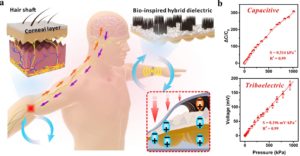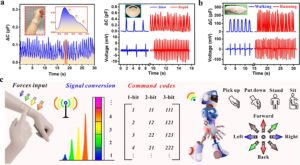A research team led by Zhou Bingpu, an assistant professor in the Institute of Applied Physics and Materials Engineering (IAPME), University of Macau (UM), has designed a novel hybrid dielectric that simultaneously enables high sensitivity and ultra-wide linearity range of wearable and flexible capacitive/triboelectric tactile sensors. The proposed sensors can operate without external power supply and can be applied for health monitoring, human-machine interaction, and intelligent control. The study has been published in Advanced Materials, a leading academic journal in the field.
In recent years, wearable and flexible sensors have attracted a lot of attention for their potential applications in areas such as healthcare monitoring, electronic skin, and intelligent communication. However, the synergistic optimisation of key parameters, such as sensitivity, linearity, and detection range, is still an important factor limiting their further development for practical applications. The effective working range of capacitive flexible tactile sensors is often limited to 10 to 100 kPa because of the non-linear dielectric behaviour of the dielectric layer and mechanical deformation, and it is difficult to simultaneously optimise key parameters such as sensitivity and linearity. The co-existence of wide linearity and high sensitivity enables the preserved detection capability across a broad pressure range, which not only favours the applications for different scenarios, but also simplifies the subsequent extraction and analysis of the electric signal.
Inspired by the structure of human skin, the research team has designed a novel hybrid dielectric composed of a low-k micro-cilia array, a high-k rough surface, and a micro-dome array. The hybrid dielectric has gradient dielectric properties and compressibility, and can be converted in series and parallel between low-k and high-k components under pressure to meet the linear variation of dielectric and mechanical properties with pressure, thus realising a capacitive sensor with linearity and stable sensitivity over a wide range of up to 1000 kPa. The hybrid dielectric is also suitable for triboelectric tactile sensors, where the hybrid structure with linear dielectric behaviour not only enhances triboelectrification and electrostatic induction, but also enables linear variation in effective surface charge density. As a result, the triboelectric sensor can serve as a self-powered device, effectively converting external tactile stimuli into voltage signals over a wide pressure range of up to 1000kPa, for real-time monitoring of human health and motion detection.
Because of the high sensitivity and ultra-wide linearity range, the sensor maintains a high resolution over a broad range of pressures. Therefore, the proposed sensors can not only perceive the physiological signals of the human body, such as pulse and breathing, in different applications for health monitoring, but can also combine applied external forces and encode capacitive or voltage signals into commands for human-machine interaction and intelligent control. As the output of commands can be realised entirely by a single sensing device, the need for integration of multiple sensing elements and complex signal processing and conversion can be avoided. The design of hybrid dielectric addresses the difficulty of separately regulating the dielectric and mechanical behaviour of conventional dielectrics and provides a novel strategy for the development of high-performance flexible tactile sensors.
The first author of the paper is PhD student Ji Bing in IAPME. This study was funded by the Science and Technology Development Fund, Macao SAR (file number: 0037/2018/A1) and UM (file number: MYRG2017-00089-FST, MYRG2018-00063-IAPME). The full version of the related paper can be viewed at: https://doi.org/10.1002/adma.202100859
澳門大學應用物理及材料工程研究院助理教授周冰樸的研究團隊設計出一種新穎的複合介電體,實現了穿戴式柔性電容式觸覺傳感器的高靈敏度和超寬線性範圍的同步優化。該器件在無外部供電的狀態下亦能夠正常運作,可以應用於健康監測、人機交互及智能控制等不同領域。該研究成果已獲國際頂級學術期刊《先進材料》(Advanced Materials)發表。
近年來,柔性可穿戴傳感器件因其在健康醫療、電子皮膚及智能交互等諸多領域的潛在應用而吸引了廣泛的關注。傳統的電容式柔性觸覺傳感器因介電層的非線性介電行爲和機械變形的限制,其有效工作範圍往往局限於10~100 kPa量級,且難以在檢測靈敏度和線性範圍等關鍵參數進行有效的同步優化,成為制約其進一步面向實際應用的重要原因之一。寬線性範圍及高靈敏度的共存,能夠確保器件在不同壓力範圍均保持出色的檢測性能,既有利於在不同場景下的應用拓展,亦簡化了後續電信號的提取及分析。
受人體皮膚結構的啓發,研究團隊設計出一種由低介電的微纖毛陣列和高介電的粗糙表面及微穹頂陣列構成的複合介電體。該複合介電體具有梯度式的介電特性和可壓縮性,能夠在不同壓力作用下實現低、高介電組分的串並聯轉換,以滿足介電性能和機械性能隨壓力的線性變化,從而實現了電容式傳感器件在高達1000 kPa的超寬範圍内維持線性工作及穩定的靈敏度。該複合介電體同樣適用於摩擦發電式觸覺傳感器,其線性介電行爲以及複合結構既可實現等效面電荷密度隨壓力的線性變化,又可增强接觸起電及靜電感應。因此,該傳感器亦可作爲一種自供電檢測設備,在同樣高達1000 kPa的超寬壓力範圍内,有效地將外力刺激線性地轉換為電壓信號,對人體的健康特征及體動等進行實時的監測。
基於同步實現的高靈敏度和超寬線性範圍,傳感器可在很寬的壓力範圍内維持對壓力的高分辨率。因此,傳感器件不僅可以感知不同應用場景中人體的生理信號(如脈搏、呼吸),用於健康監測,還可組合施加的外力,將電容或電壓信號編碼為控制指令,用於人機交互及智能控制。由於控制指令的輸出可完全由單個傳感器件實現,避免了多傳感元件集成化的需求以及複雜的信號處理和轉換。該複合介電體的設計解決了傳統介電體的介電行爲和機械行爲難以分別調控的問題,為高性能柔性觸覺傳感器的發展提供了新穎的策略。
論文的第一作者為澳門大學應用物理及材料工程研究院博士生冀冰。此項研究由澳門特別行政區科學技術發展基金(檔案編號:0037/2018/A1)及澳門大學(檔案編號:MYRG2017-00089-FST, MYRG2018-00063-IAPME)資助。文章全文可瀏覽:https://doi.org/10.1002/adma.202100859
a) 仿皮膚結構和功能的仿生複合介電體
b) 柔性電容式及摩擦發電式觸覺傳感器的超寬線性傳感性能
a) Bio-inspired hybrid dielectric imitating the structure and function of human skin;
and b) Ultra-wide linear sensing of flexible capacitive and triboelectric tactile sensors
穿戴式傳感器在a) 健康監測(脈搏、呼吸),
b) 體動行為,及c) 智能控制(指令輸出)等方面的潛在應用展示
The potential applications of the wearable sensors in a) healthcare monitoring (pulse and breathing),
b) body motion, and c) intelligent control (command output)



